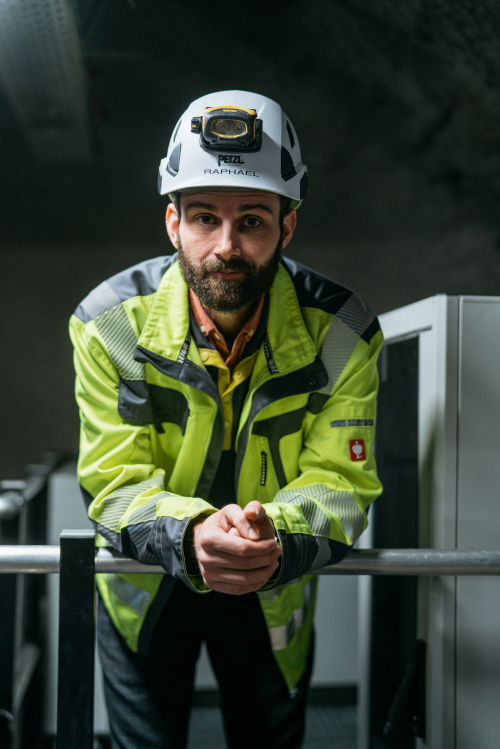Bentonite plays an important role in the design of engineered barrier systems (EBS) for radioactive waste repositories aimed at safely isolating radioactive waste from the environment. Its unique properties - low permeability, high swelling capacity and ability to self-seal fractures - make it an ideal material for limiting groundwater flow and retarding any radionuclide which might be released from the waste canisters (Figure 1).
However, understanding the long-term behavior of bentonite under repository conditions is important for demonstrating the safety and effectiveness of the EBS over the geological timescales required by safety regulations.
Natural analogues provide valuable insights into the processes that may affect bentonite performance over extended periods. One notable example is the presence of bentonites in the iron ore mine beneath the village of Kiruna in northern Sweden (Alexander et al. 2024).
These very old bentonites (they may be up to 100 million years old), which have experienced:
- prolonged interactions with groundwater
- massive temperature fluctuations
- geochemical changes
- interaction with iron corrosion products
offer an unique opportunity to study the very long-term durability and stability of bentonites in natural settings similar to a deep radioactive waste repository.
The ancient bentonite at Kiruna
The Kiruna iron ore mine, located in the Norrbotten region of northern Sweden (Figure 2), is situated within the Fennoscandian Shield, a Precambrian craton which covers much of Norway, Sweden, Finland and NW Russia. The mine is hosted in Palaeoproterozoic (ca. 1.88 billion year old) volcanic and sedimentary rocks (see the KINA report in the NAWG library for details).
The presence of bentonite in the Kiruna district is primarily linked to hydrothermal alteration which affected both the host volcanic rocks and the ore itself, and the bentonite is often found in alteration halos surrounding the ore bodies.
The Kiruna mine:
- The Kiruna mine in northern Sweden (Figure 2, top) consists of massive magnetite deposits with minor haematite, classified as an apatite-iron oxide ore (Kiruna-type). These deposits are associated with felsic volcanic rocks, primarily rhyolites and trachyandesites, and are thought to have formed in a submarine volcanic setting, possibly through a combination of magmatic and hydrothermal processes.
- The region has undergone multiple phases of deformation and metamorphism, most notably during the Svecokarelian orogeny (~1.9–1.8 billion years ago), which contributed to the current structural complexity. The mineralisation is also spatially related to large-scale fault zones and granitic intrusions, which may also have played a role in ore emplacement.
- Hydrothermal alteration of the host rocks produced many minerals including sericite, chlorite, and various clay minerals, such as illite, smectite (the main constituent of the ancient bentonites) and kaolinite. These minerals form through the hydrothermal alteration of feldspars and volcanic glass in the original volcanic rocks. In deeper and hotter zones, chlorite and illite tend to dominate, whereas near-surface conditions favour smectite and kaolinite.
Performance
The natural bentonite collected in the mine beneath Kiruna (Figure 3) was compared with commercially available bentonite which will be used in a repository EBS with respect to three main relevant properties:
- hydraulic conductivity
- swelling pressure
- stability against erosion.
The hydraulic conductivity of the natural Kiruna bentonite is more or less equal to commercially available bentonite, whereas the swelling pressure is somewhat lower. The stability against erosion in laboratory experiments appears to be higher than for commercially available bentonite. In addition, although there are concerns that the performance of bentonite in a repository may be affected by iron corrosion products from the steel canisters around the waste, no iron uptake was observed in the ancient bentonites in Kiruna, despite them being in intimate contact with the iron ore for up to 100 million years. These results indicate that the ancient bentonites in the Kiruna mine have been very stable for extremely long timescales, increase our confidence in the likely long-term behaviour of the commercially available bentonites which will be employed in the EBS in future radioactive waste repositories
Conclusion
The Kiruna natural analogue appears to be a reasonable analogy for the very long-term evolution of the commercial bentonite in the EBS within a deep radioactive waste repository. The ancient bentonite in the mine is characterised by similar properties with respect to hydraulic conductivity, swelling stability against erosion and resistance to iron uptake as commercially available bentonites. One important topic which is currently still under investigation is the presence and possible role of microbes in the bentonite.
 Figure 1: Example of the multiple engineered barrier concept for radioactive waste disposal in steel canisters, with a bentonite backfill surrounding the waste containers (Image: Nagra).
Figure 1: Example of the multiple engineered barrier concept for radioactive waste disposal in steel canisters, with a bentonite backfill surrounding the waste containers (Image: Nagra).
 Figure 2: Top: the Kiruna iron mine is situated (black frame) in northern Sweden. Bottom: simplified geological map of the northern Norrbotten area with the location of Kiruna village and its iron ore deposit (black star) which is associated with the ancient bentonite studies reported here as natural analogues of the commercial bentonites used as part of the repository EBS (see the KINA report: Alexander et al. 2024, for details).
Figure 2: Top: the Kiruna iron mine is situated (black frame) in northern Sweden. Bottom: simplified geological map of the northern Norrbotten area with the location of Kiruna village and its iron ore deposit (black star) which is associated with the ancient bentonite studies reported here as natural analogues of the commercial bentonites used as part of the repository EBS (see the KINA report: Alexander et al. 2024, for details).
 Figure 3: collecting drillcore samples in the Kiruna mine in northern Sweden (Alexander et al. 2024).
Figure 3: collecting drillcore samples in the Kiruna mine in northern Sweden (Alexander et al. 2024).
References
Alexander, W.R. (ed) 2024. KINA (Kiruna Natural Analogue) project. Final report. SKB TR-24-01. Svensk Kärnbränslehantering AB, Stockholm, Sweden. 226p. https://skb.com/publication/2514964/TR-24-01.pdf

